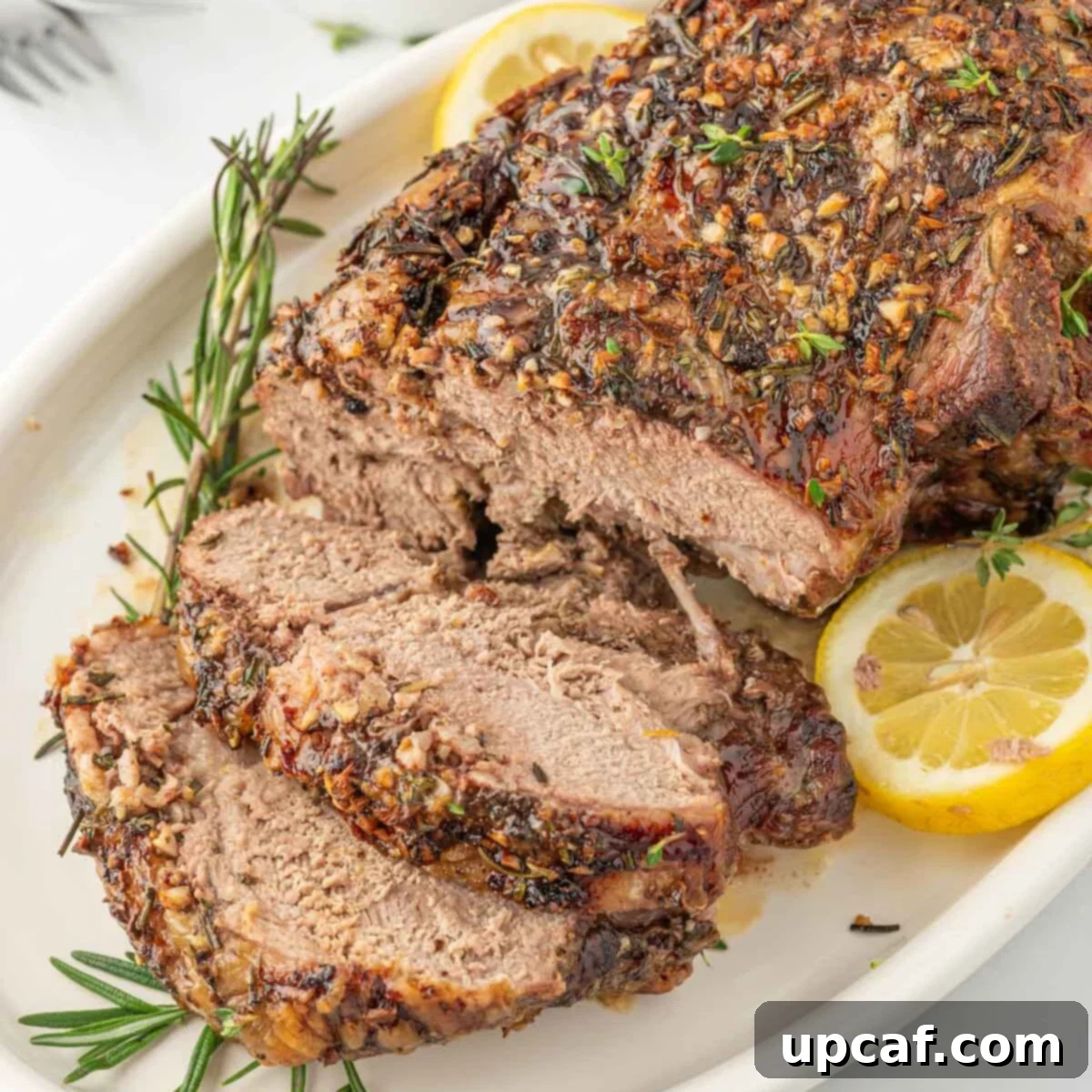Unlock the secret to a perfectly tender, aromatic, and incredibly juicy lamb dish with this exquisite Boneless Leg of Lamb recipe. Infused with the vibrant flavors of the Mediterranean, every bite offers a harmonious blend of herbaceous rosemary, pungent garlic, and a zesty hint of lemon. This show-stopping roast is designed to melt in your mouth, leaving a lasting impression of rich, savory goodness.

Whether you’re planning a festive holiday feast, a special family gathering, or simply craving a sophisticated yet approachable meal, this recipe is a year-round favorite. The choice of a boneless leg of lamb is a game-changer, significantly reducing cooking time and simplifying the carving process. Moreover, a boneless cut allows you to easily butterfly the lamb, removing excess fat and creating pockets for an even deeper infusion of our signature Mediterranean marinade. This technique ensures maximum flavor penetration, guaranteeing a succulent and aromatic roast from the inside out.
If you’re a connoisseur of lamb dishes, you absolutely must try my Mediterranean Lamb Chops Recipe. It’s another effortlessly delicious creation that promises to tantalize your taste buds.
Ingredient Notes & Expert Substitutions for Your Perfect Roast
Crafting an exceptional boneless leg of lamb begins with selecting high-quality ingredients. For the most vibrant and authentic Mediterranean taste, I wholeheartedly recommend opting for fresh herbs and aromatics whenever possible. The difference in flavor is truly remarkable and elevates this dish from good to unforgettable.
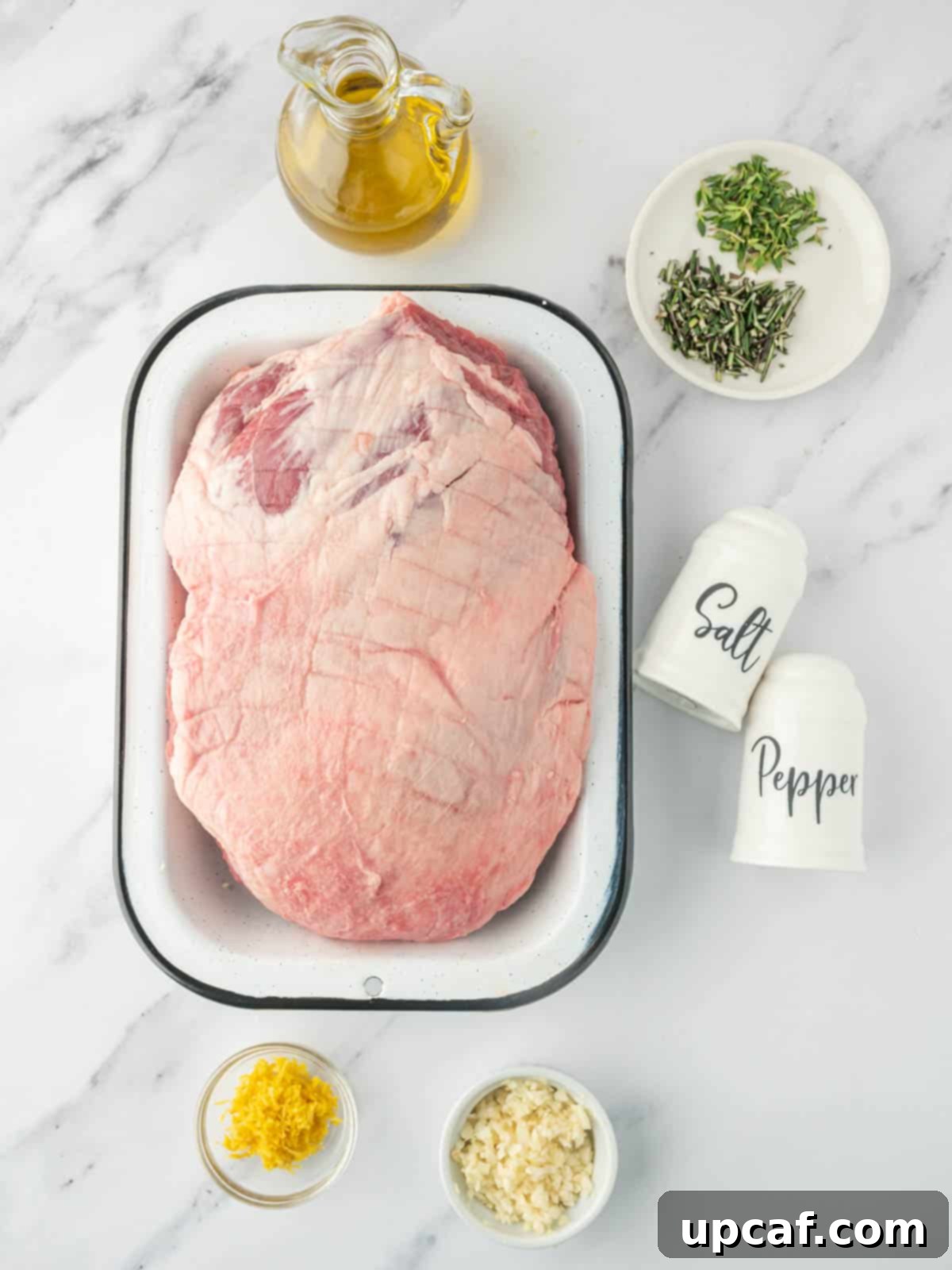
Here’s a detailed look at the key components for your marinade and roast:
| Ingredient | Why It’s Essential | Best Substitute |
|---|---|---|
| Boneless Lamb Leg (5-7 lbs) | The star of our dish, chosen for its tenderness, uniform cooking, and ease of carving. Ideal for absorbing marinades. | Bone-in leg (plan for an additional 10-15 minutes of cooking time per pound). |
| Fresh Garlic (3 tablespoons, finely chopped) | Provides a robust, aromatic foundation. Fresh garlic offers an unparalleled sharp and pungent flavor that dried garlic simply cannot replicate. | 1 teaspoon garlic powder per clove (use 1.5-2 teaspoons for this recipe, though fresh is highly preferred). |
| Fresh Lemon Juice (2 tablespoons) | Adds a bright, tangy acidity that cuts through the richness of the lamb, tenderizes the meat, and enhances all other flavors. | Bottled lemon juice (use sparingly and taste for balance, as it can be less vibrant). |
| Fresh Rosemary (2 teaspoons, chopped) | Delivers an earthy, piney, and distinctly aromatic flavor that is quintessential to Mediterranean lamb dishes. | 1 teaspoon dried rosemary (use half the amount as dried herbs are more concentrated). |
| Lemon Zest (2 teaspoons) | Captures the intense, fragrant citrus oils from the lemon peel, providing a deeper lemon essence without adding extra liquid. | A pinch of dried lemon peel (less aromatic, adjust to taste). |
| Fresh Thyme (1 tablespoon) | Offers a subtle, earthy, and slightly floral note that beautifully complements the rosemary and garlic. | Dried thyme (use about half a tablespoon). |
| Olive Oil (½ cup) | Serves as the base for our marinade, helping to distribute flavors, keep the lamb moist, and create a beautiful crust. Choose a good quality extra virgin olive oil for best results. | Any neutral-flavored oil like avocado oil or grapeseed oil. |
| Salt (1 teaspoon) & Ground Pepper (1 teaspoon) | These essential seasonings enhance all other flavors and are crucial for bringing out the natural deliciousness of the lamb. Adjust to your personal taste preference. | Adjust to taste. |
| Lemon wedges to garnish | For a final touch of freshness and visual appeal. | Optional. |
Mastering the Art of Roasting Boneless Leg Of Lamb
Achieving a perfectly roasted boneless leg of lamb is simpler than you might think. Follow these straightforward steps to create a tender, juicy, and incredibly flavorful centerpiece for your meal. The secret lies in proper preparation, a flavorful marinade, and precise temperature control.
- Prepare Your Oven & Baking Sheet: Begin by preheating your oven to a robust 400°F (200°C). For effortless cleanup, line a sturdy, rimmed baking sheet with aluminum foil. This initial high heat will create a magnificent browned crust on the lamb, locking in juices and developing rich flavors.
- Craft the Aromatic Marinade: In a medium-sized bowl, combine the extra virgin olive oil, finely minced fresh garlic, fresh lemon juice, freshly chopped rosemary, fragrant thyme, bright lemon zest, sea salt, and freshly ground black pepper. Whisk these ingredients together thoroughly until they are well combined, creating a thick, aromatic paste. This marinade is the heart of our Mediterranean flavor profile.
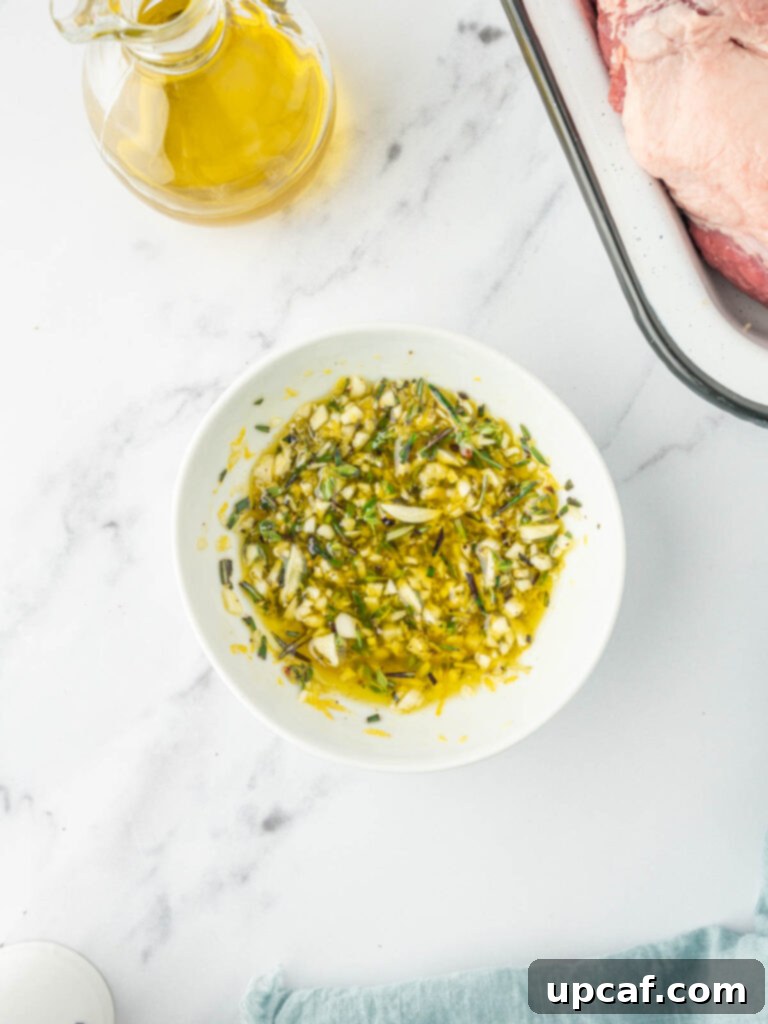
- Score the Lamb for Maximum Flavor: Pat the boneless lamb leg completely dry with paper towels. This crucial step helps create a crispier exterior. Using a sharp knife, make small, shallow diagonal cuts (approximately ¼ inch deep) all over the surface of the lamb. These cuts serve multiple purposes: they allow the vibrant marinade to penetrate deeper into the meat, ensuring every fiber is infused with flavor, and they help the fat render more efficiently, resulting in a less greasy, more tender roast.
- Marinate for Deep Flavor Infusion: Place the scored lamb leg onto your prepared baking sheet. Generously rub the aromatic marinade mixture all over the lamb, paying special attention to massage it into all the cuts and natural folds of the meat. This hands-on step ensures even distribution of flavor. For optimal results and a deeply satisfying taste, allow the lamb to marinate at room temperature for at least 30 minutes.
👉 Make-Ahead Tip: To achieve an even more profound flavor profile, cover the marinated lamb tightly and refrigerate it overnight. Before roasting, remember to bring the lamb back to room temperature for at least 30 minutes. This allows for more even cooking and helps prevent the meat from seizing when it hits the hot oven.
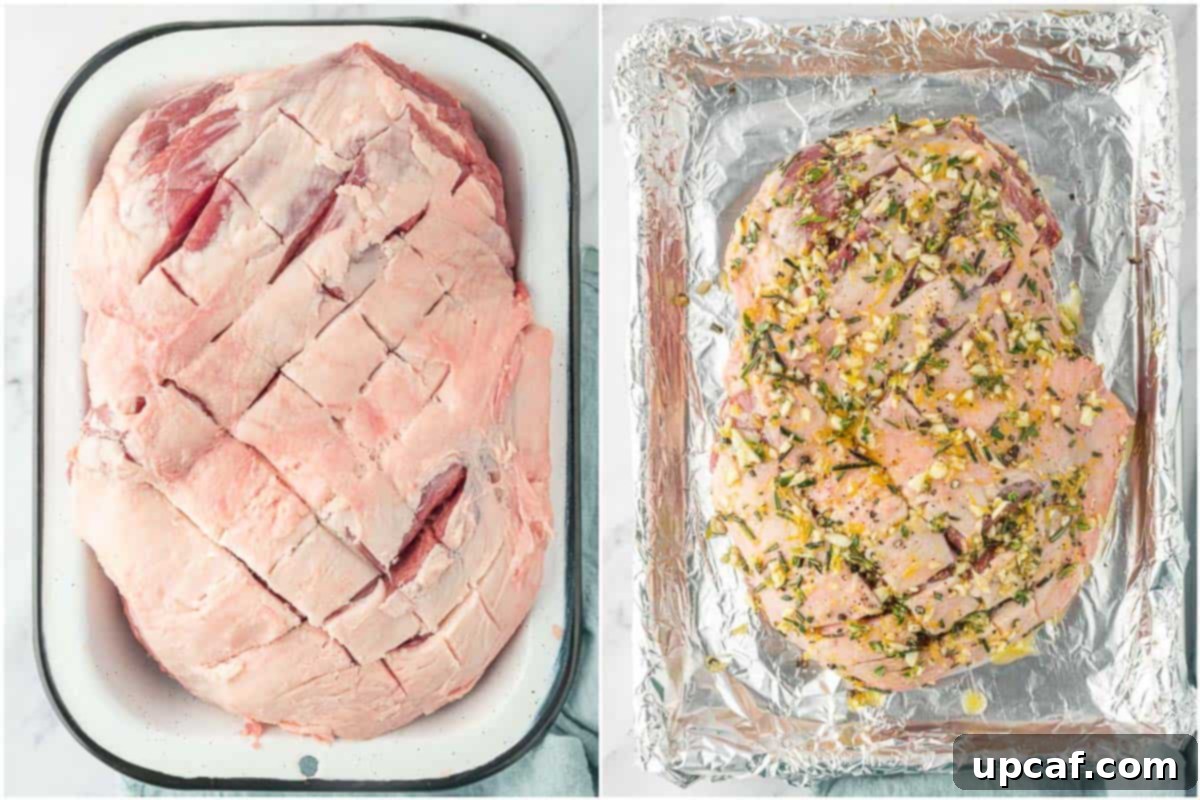
- Initial High-Heat Roast: Place the marinated lamb in the preheated 400°F (200°C) oven and roast for an initial 20 minutes. This burst of high heat is vital for developing a beautiful, browned crust on the exterior of the lamb, contributing to both texture and depth of flavor through the Maillard reaction.
- Finish Cooking at Lower Temperature: Without opening the oven door, reduce the oven temperature to 350°F (175°C). Continue roasting for approximately 1 hour and 15 to 30 minutes. The exact cooking time will vary based on the size and thickness of your lamb leg and your desired level of doneness. The most accurate way to determine doneness is by using a reliable meat thermometer. Aim for an internal temperature of 140-145°F (60-63°C) for a perfect medium-well roast.
👉 Pro Tips for Roasting Success:- Always Use a Meat Thermometer: This is your most valuable tool for guaranteed perfection. Insert the thermometer into the thickest part of the lamb, avoiding any bones or pockets of fat, to get an accurate reading.
- Baste for Enhanced Flavor and Moisture: Every 30 minutes or so, baste the lamb with the accumulated pan juices or any leftover marinade. This simple step adds an extra layer of flavor and helps keep the meat wonderfully moist throughout the roasting process.
🌡️ Essential Doneness Temperature Guide for Lamb
Understanding internal temperatures is crucial for achieving your preferred level of doneness:
- Rare: 120-125°F (49-52°C) – Very red center, cool.
- Medium Rare: 130-135°F (54-57°C) ← Chef’s Recommended Doneness – Pink center, warm.
- Medium: 140-145°F (60-63°C) – Light pink center.
- Medium Well: 150-155°F (66-68°C) – Slightly pink center.
- Well Done: 160°F+ (71°C+) – No pink, thoroughly cooked.
👉 Pro Tip: Remember that the temperature will rise by 5-10 degrees during the resting period (known as carryover cooking), so remove the lamb from the oven slightly before it reaches your target temperature.

- The Mandatory Resting Period: Once the lamb has reached your desired internal temperature, promptly remove it from the oven. Transfer the succulent roast to a clean cutting board and tent it loosely with aluminum foil. Allow the lamb to rest undisturbed for 15-20 minutes. This resting period is non-negotiable! It allows the muscle fibers to relax and reabsorb all the delicious juices that have migrated to the center during cooking. Skipping this step will result in juices spilling out onto your cutting board, leaving you with dry meat.
⚠️ Important: Be mindful of carryover cooking; the internal temperature of the lamb will continue to rise by 5-10 degrees during this rest. - Slice Against the Grain & Serve: After the essential resting period, it’s time to carve and enjoy! Using a sharp carving knife, slice the lamb against the grain. This means cutting perpendicular to the direction the muscle fibers run, which ensures maximum tenderness in every slice. Serve your magnificent roasted lamb immediately, drizzled generously with any accumulated pan juices for an extra burst of flavor.
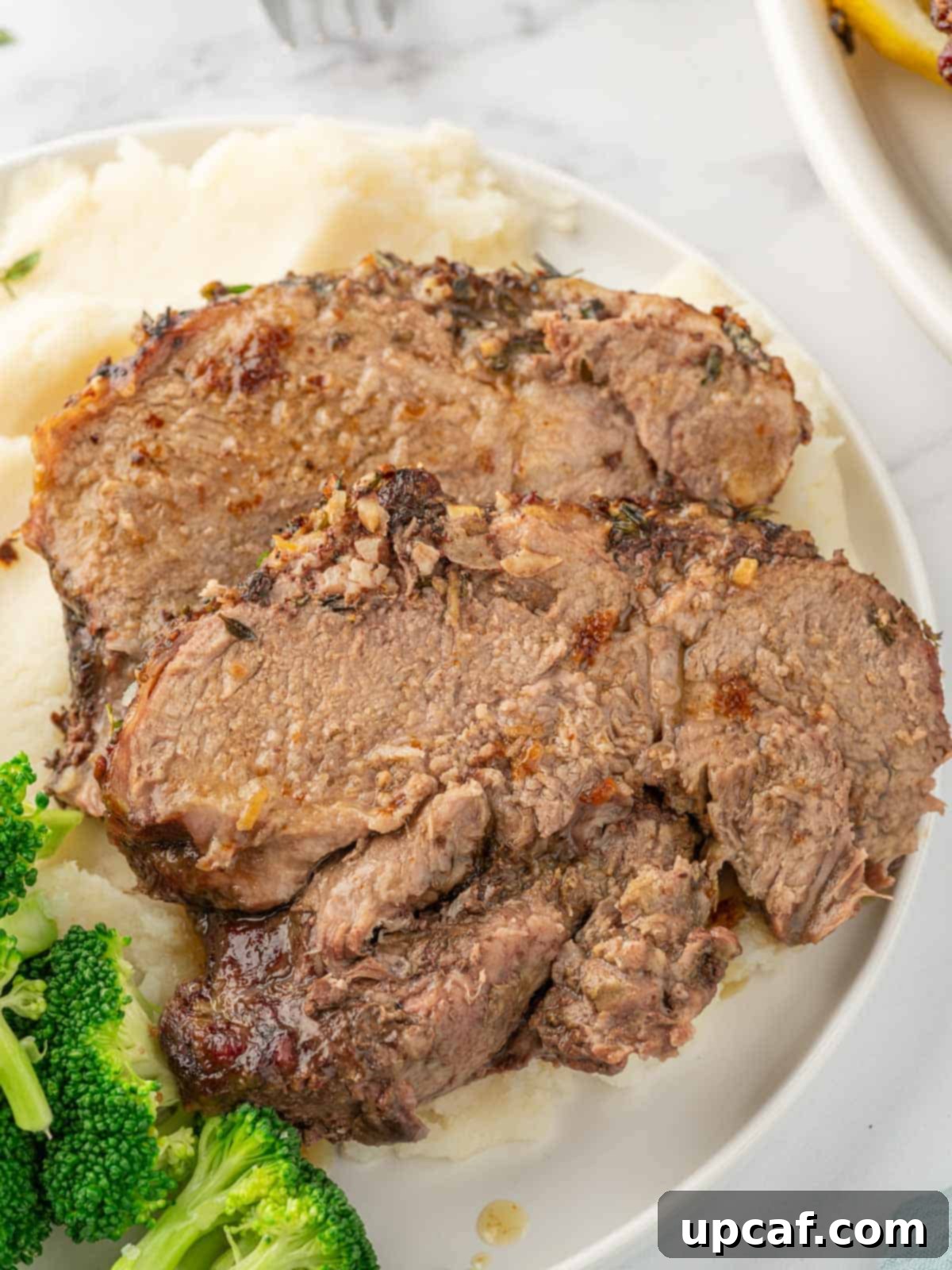
Storing and Reheating Your Leftover Lamb
Should you be lucky enough to have any leftover roasted lamb, proper storage and reheating techniques will ensure it remains just as delicious the next day:
- Refrigerator Storage: Allow the cooked lamb to cool completely before transferring it to an airtight container. It will keep fresh in the refrigerator for 3-4 days.
- Freezer Storage: For longer storage, cool the lamb, then wrap individual portions tightly in aluminum foil, followed by a layer of plastic wrap or an airtight freezer-safe bag. It can be frozen for up to 3 months. Thaw frozen lamb in the refrigerator overnight before reheating.
- Reheating Instructions:
- Oven Method: Preheat your oven to 325°F (160°C). Place the lamb slices or whole piece in an oven-safe dish, add a splash of broth or water to keep it moist, and cover tightly with foil. Reheat for 15-20 minutes, or until warmed through, being careful not to overcook.
- Air Fryer Method: For smaller portions, an air fryer works wonderfully. Place lamb slices in the air fryer basket at 320°F (160°C) for 3-5 minutes, or until heated through.
Perfect Pairings: Delectable Sides To Serve With Your Roasted Lamb Leg
A magnificent roasted lamb leg deserves equally impressive side dishes to complete the culinary experience. Here are some thoughtfully selected options, ranging from classic comforts to fresh, lighter choices, that perfectly complement the rich flavors of our Mediterranean lamb.
| Classic & Comforting Sides | Fresh & Lighter Options |
|---|---|
| 🥔 Creamy Cheesy Mashed Potatoes – The ultimate comfort food, perfect for soaking up those savory lamb juices. | 🥗 Easy Greek White Bean Salad – A refreshing and zesty salad that balances the richness of the lamb. |
| 🫘 Hearty Green Bean Casserole – A holiday staple, offering a creamy, savory contrast. | 🌱 Garlic Parmesan Green Beans – Simple, flavorful, and a great way to add some vibrant green vegetables. |
| 🥕 Sweet Sugar Glazed Carrots – A touch of sweetness that pairs beautifully with the savory lamb. | 🥔 Crispy Roasted Baby Potatoes – Golden and tender, these potatoes are a perfect textural and flavorful match. |
| 🍄 Savory Roasted Garlic Butter Mushrooms – Earthy and rich, they add a wonderful depth to the plate. | 🥗 Easy Sautéed Mixed Vegetables – A quick and versatile option to round out your meal with fresh goodness. |
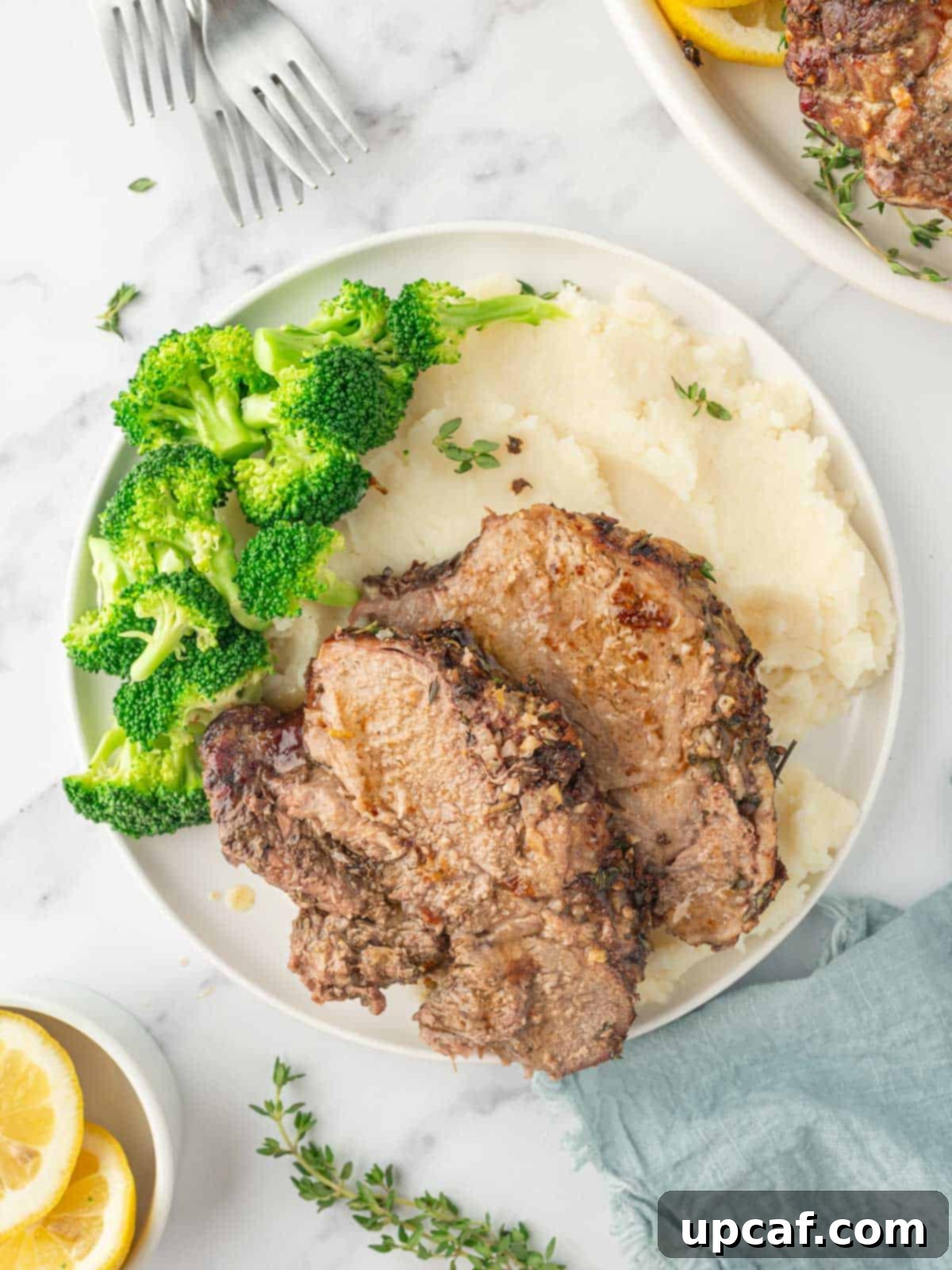
Frequently Asked Questions About Roasting Lamb
Absolutely! A bone-in leg of lamb is an excellent choice and can impart an even richer flavor to your roast, as the bone itself contributes to the depth of taste. The primary difference you’ll need to account for is the cooking time. Plan for an additional 10-15 minutes of roasting time per pound compared to the instructions provided for a boneless leg. Always rely on a meat thermometer inserted near the bone (without touching it) for accurate doneness.
Resting the meat after cooking is perhaps one of the most critical steps, and it’s non-negotiable for a truly juicy roast. During cooking, the muscle fibers contract, pushing the meat’s internal juices towards the center. If you slice the lamb immediately after removing it from the oven, these juices will simply run out onto your cutting board, leaving the meat dry and less flavorful. Resting allows the muscle fibers to relax and reabsorb those precious juices, redistributing them evenly throughout the entire roast, resulting in tender, succulent meat every time.
Always slice lamb (and most other meats) against the grain. To do this, observe the direction in which the muscle fibers are running. Then, use a sharp, thin carving knife to cut perpendicular to those fibers. Slicing against the grain shortens the muscle fibers, making each piece more tender and easier to chew. This technique significantly enhances the eating experience.
While rosemary, garlic, and lemon are a classic and unbeatable combination for lamb, many other herbs and spices can create delicious variations. Consider fresh oregano, mint (especially in a sauce or rub), marjoram, or even a hint of cumin or smoked paprika for a different twist. Bay leaves can also add a subtle background note to your marinade or roasting pan.
Several factors contribute to a great crust. First, ensure your lamb leg is thoroughly patted dry before marinating and roasting. Moisture on the surface prevents browning. Second, the initial high-heat roast (400°F/200°C) is key to initiating the Maillard reaction, which creates that desirable browned crust. Finally, scoring the lamb not only helps with flavor penetration but also allows fat to render and the surface to crisp up more effectively.
I genuinely hope you enjoy creating and savoring this incredible Boneless Leg of Lamb recipe. If you try this dish or any of my other recipes, please leave a star rating and a comment in the section below to share your experience! Your feedback is incredibly valuable. You can also follow me at Cookin’ With Mima on Facebook | Instagram | Pinterest for all my latest culinary posts and new recipes.
Boneless Leg of Lamb Recipe

Juicy, flavorful boneless leg of lamb roasted with garlic & herbs. An impressive yet EASY dinner recipe perfect for holidays or special occasions.
- Prep Time: 40 minutes
- Cook Time: 1 hour 45 minutes
- Resting Time: 15 minutes
- Total Time: 2 hours 40 minutes
- Servings: 6 servings
- By: Mariam Ezzeddine
Ingredients
- 5-7 lb boneless lamb leg
- ½ cup olive oil
- 3 tablespoons garlic, finely chopped
- 2 tablespoons fresh lemon juice
- 2 teaspoons fresh rosemary, chopped
- 2 teaspoons fresh lemon zest
- 1 tablespoon fresh thyme
- 1 teaspoon salt
- 1 teaspoon ground pepper
- Lemon wedges to garnish (optional)
Instructions
- Preheat Oven: Preheat your oven to 400°F (200°C). Line a rimmed baking sheet with aluminum foil for easy cleanup.
- Make the Marinade: In a small bowl, combine the olive oil, minced garlic, lemon juice, chopped rosemary, thyme, lemon zest, salt, and pepper. Whisk until well combined.
- Score the Lamb: Pat the boneless lamb leg completely dry with paper towels. Using a sharp knife, make small, shallow diagonal cuts (about ¼ inch deep) all over the surface. This helps the marinade penetrate and allows fat to render.
- Marinate: Place the lamb on the prepared baking sheet. Rub the marinade mixture all over the lamb, massaging it into the cuts and folds. For the best flavor, let it marinate for at least 30 minutes at room temperature.
- Roast: Initial High Heat: Place the lamb in the preheated oven and roast at 400°F for 20 minutes. This creates a delicious browned crust.
- Finish Cooking: Without opening the oven door, reduce the heat to 350°F (175°C). Continue roasting for about 1 hour and 15-30 minutes, or until the internal temperature reaches 145°F (63°C) for medium-well.
- Rest is Mandatory: Once done, remove the lamb from the oven. Transfer it to a clean cutting board and tent it loosely with foil. Let it rest for 15-20 minutes. This allows the juices to redistribute, resulting in tender, juicy meat.
- Slice and Serve: Slice the lamb against the grain and serve immediately with any accumulated juices.
Chef’s Notes for Success
- Make-Ahead Tip: For deeper flavor, cover and marinate in the refrigerator overnight. Let it sit at room temperature for 30 minutes before roasting.
- Bring Meat to Room Temperature: Allow the lamb to come to room temperature for 30-60 minutes before roasting for more even cooking.
- Use a Meat Thermometer: This is the most accurate way to guarantee perfect doneness and avoid overcooking or undercooking.
- Baste the Meat: Baste the lamb with the marinade or pan juices every 30 minutes. This adds extra flavor and helps keep the meat moist.
- Let it Rest: Covering the lamb with foil and letting it rest for at least 15-20 minutes after removing it from the oven allows juices to redistribute, ensuring juicy and tender meat.
Nutrition Information (Per Serving)
Calories: 473 kcal | Carbohydrates: 2g | Protein: 49g | Fat: 29g | Saturated Fat: 6g | Polyunsaturated Fat: 3g | Monounsaturated Fat: 17g | Cholesterol: 152mg | Sodium: 537mg | Potassium: 722mg | Fiber: 0.4g | Sugar: 0.2g | Vitamin A: 59 IU | Vitamin C: 6mg | Calcium: 29mg | Iron: 5mg
